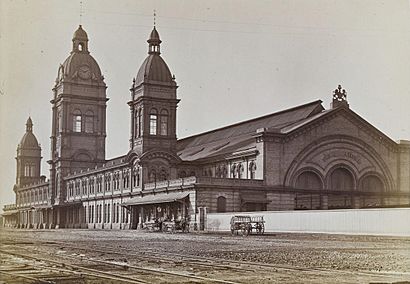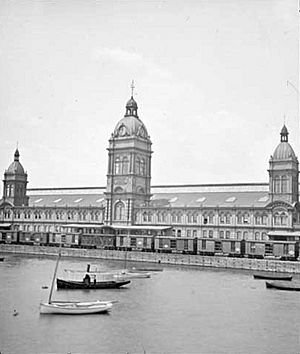Toronto Union Station (1873) facts for kids
Quick facts for kids
Union Station
|
|
|---|---|
 |
|
| Location | 7 Station Street Toronto, Ontario Canada |
| Coordinates | 43°38′41″N 79°23′1″W / 43.64472°N 79.38361°W |
| Owned by | Grand Trunk Railway |
| Construction | |
| Architect | Thomas Seaton Scott |
| Architectural style | Italianate/Second Empire |
| History | |
| Opened | 1878 |
| Closed | 1927 |
Imagine a busy train station in old Toronto! The second Union Station was a big train hub in downtown Toronto. It was built by the Grand Trunk Railway (GTR) and opened in 1873. This new station took the place of an older one right in the same spot.
Contents
A Look Back: Early Toronto Train Stations
Before this grand Union Station, Toronto had an earlier train station. The first Union Station was built by the Grand Trunk Railway in 1858. It was made of three wooden buildings. At first, it was shared by a few different railway companies. But soon, these companies also built their own stations along the Toronto waterfront.
Why a New Station Was Needed
By the 1870s, the old wooden station was too small. It could not handle all the trains and people. So, the Grand Trunk Railway decided to build a brand new Union Station. It opened on July 1, 1873, in the very same spot.
Building a Grand New Station
When it opened, the 1873 Union Station was the biggest and fanciest train station in all of Canada. It was designed by a famous architect named Thomas Seaton Scott. He also designed another big station in Montreal. The station's main entrance faced the harbour. This made it easy for people to switch from boats on Lake Ontario to trains.
More Trains, More People
Over time, the Grand Trunk Railway bought smaller railway companies. This meant more and more trains started using Union Station. When the Canadian Pacific Railway arrived in 1884, traffic grew even more. Soon, over sixty trains were using the station every day!
Expanding the Station in the 1890s
By 1892, the station needed to be even bigger. The railway companies agreed to a huge expansion project. A new train shed was built for more tracks. The most exciting new part was a seven-story office building on Front Street. This building was made of red brick and looked very grand. It opened to the public on January 1, 1896.
Challenges and a New Beginning
Even with the expansions, the station was not perfect. It was a very large building, but it was often confusing and hard to use. People thought it was one of the most inconvenient stations in North America.
The Great Toronto Fire and New Plans
In 1904, a huge fire swept through Toronto. It destroyed many buildings, including the area right next to Union Station. After the fire, it was decided in 1905 to build a new new Union Station on this empty land.
However, the railway companies and the city could not agree on the plans. They argued about the design and how the train tracks should enter the station. Meanwhile, the old Union Station kept serving Toronto, even though no one was happy with it.
A Busy Hub: 150 Trains a Day!
By 1911, the station was incredibly busy. About 150 trains and 40,000 people used it every single day!
Building the Final Union Station
Construction on the newest Union Station began in 1915. But there were many delays. World War I meant fewer workers and building materials. Also, some railway companies faced money problems.
The main part of the new Union Station was finished in 1920. But it did not open for another seven years! The railways and the city were still arguing about the tracks.
Finally, on August 10, 1927, the new Union Station opened its doors. The old station was taken apart over the next year. The clock faces from its tower were saved. They were later given to the town of Huntsville, Ontario and put on their town hall building. The big office building on Front Street was torn down in 1931.
Today, the area where the old Union Station stood is very different. It now has the SkyWalk pedestrian bridge, a station for the UP Express train, and a modern office building.
Images for kids









